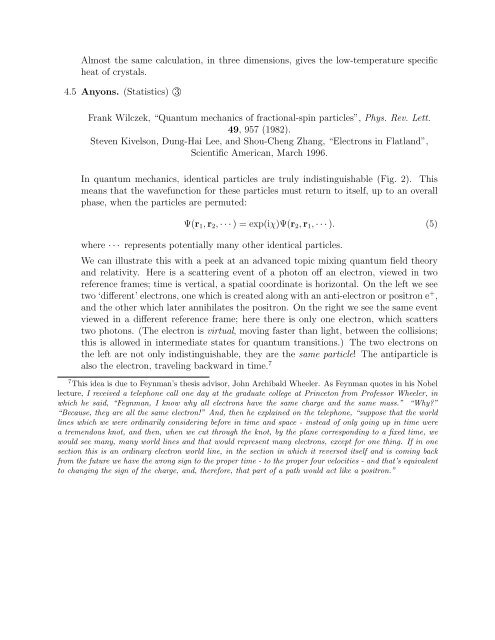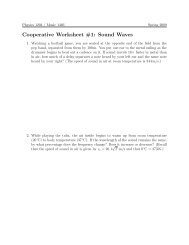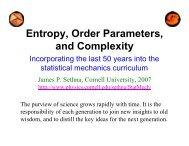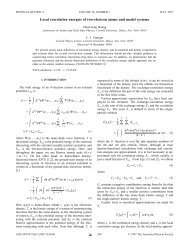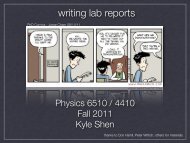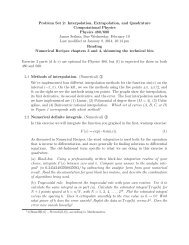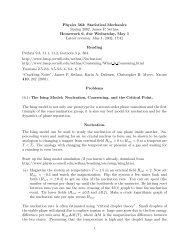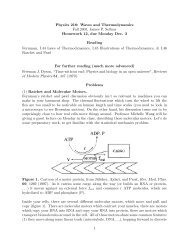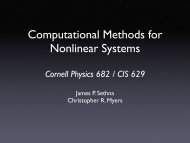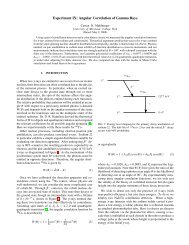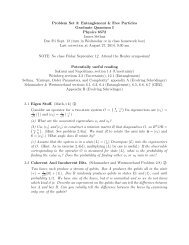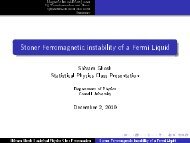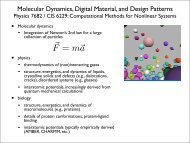4. Bosons, Fermions, and Anyons - Are you sure you want to look at ...
4. Bosons, Fermions, and Anyons - Are you sure you want to look at ...
4. Bosons, Fermions, and Anyons - Are you sure you want to look at ...
You also want an ePaper? Increase the reach of your titles
YUMPU automatically turns print PDFs into web optimized ePapers that Google loves.
Almost the same calcul<strong>at</strong>ion, in three dimensions, gives the low-temper<strong>at</strong>ure specifiche<strong>at</strong> of crystals.<strong>4.</strong>5 <strong>Anyons</strong>. (St<strong>at</strong>istics) ○3Frank Wilczek, “Quantum mechanics of fractional-spin particles”, Phys. Rev. Lett.49, 957 (1982).Steven Kivelson, Dung-Hai Lee, <strong>and</strong> Shou-Cheng Zhang, “Electrons in Fl<strong>at</strong>l<strong>and</strong>”,Scientific American, March 1996.In quantum mechanics, identical particles are truly indistinguishable (Fig. 2). Thismeans th<strong>at</strong> the wavefunction for these particles must return <strong>to</strong> itself, up <strong>to</strong> an overallphase, when the particles are permuted:Ψ(r 1 , r 2 , · · · ) = exp(iχ)Ψ(r 2 , r 1 , · · · ). (5)where · · · represents potentially many other identical particles.We can illustr<strong>at</strong>e this with a peek <strong>at</strong> an advanced <strong>to</strong>pic mixing quantum field theory<strong>and</strong> rel<strong>at</strong>ivity. Here is a sc<strong>at</strong>tering event of a pho<strong>to</strong>n off an electron, viewed in tworeference frames; time is vertical, a sp<strong>at</strong>ial coordin<strong>at</strong>e is horizontal. On the left we seetwo ‘different’ electrons, one which is cre<strong>at</strong>ed along with an anti-electron or positron e + ,<strong>and</strong> the other which l<strong>at</strong>er annihil<strong>at</strong>es the positron. On the right we see the same eventviewed in a different reference frame; here there is only one electron, which sc<strong>at</strong>terstwo pho<strong>to</strong>ns. (The electron is virtual, moving faster than light, between the collisions;this is allowed in intermedi<strong>at</strong>e st<strong>at</strong>es for quantum transitions.) The two electrons onthe left are not only indistinguishable, they are the same particle! The antiparticle isalso the electron, traveling backward in time. 77 This idea is due <strong>to</strong> Feynman’s thesis advisor, John Archibald Wheeler. As Feynman quotes in his Nobellecture, I received a telephone call one day <strong>at</strong> the gradu<strong>at</strong>e college <strong>at</strong> Prince<strong>to</strong>n from Professor Wheeler, inwhich he said, “Feynman, I know why all electrons have the same charge <strong>and</strong> the same mass.” “Why?”“Because, they are all the same electron!” And, then he explained on the telephone, “suppose th<strong>at</strong> the worldlines which we were ordinarily considering before in time <strong>and</strong> space - instead of only going up in time werea tremendous knot, <strong>and</strong> then, when we cut through the knot, by the plane corresponding <strong>to</strong> a fixed time, wewould see many, many world lines <strong>and</strong> th<strong>at</strong> would represent many electrons, except for one thing. If in onesection this is an ordinary electron world line, in the section in which it reversed itself <strong>and</strong> is coming backfrom the future we have the wrong sign <strong>to</strong> the proper time - <strong>to</strong> the proper four velocities - <strong>and</strong> th<strong>at</strong>’s equivalent<strong>to</strong> changing the sign of the charge, <strong>and</strong>, therefore, th<strong>at</strong> part of a p<strong>at</strong>h would act like a positron.”


